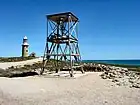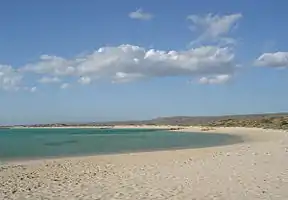| Cape Range National Park Western Australia | |
|---|---|
 Cape Range Landscape | |
| Nearest town or city | Exmouth |
| Coordinates | 22°07′24″S 113°55′14″E / 22.12333°S 113.92056°E |
| Population | 18 (SAL 2021)[1] |
| Established | 1965 |
| Area | 476.55 km2 (184.0 sq mi)[2] |
| Managing authorities | Parks and Wildlife Service, Department of Biodiversity, Conservation and Attractions |
| Website | Cape Range National Park |
| See also | List of protected areas of Western Australia |
Cape Range National Park is a national park in the Gascoyne region of Western Australia, 1,105 kilometres (687 mi) north of Perth. The park occupies the western side of the North West Cape peninsula over an area of 47,655 hectares (117,760 acres). The nearest town is Exmouth. Directly off the coast is the Ningaloo Reef. The area resulted from a gradual uplifting from the sea floor followed by fluctuating sea levels, wind and water erosion that have slowly eroded the range and plain leaving behind a range of rugged limestone, deep canyons and pristine beaches.
Overview
The Cape is the only elevated plateau composed of limestone on the North West Coast. The range has plateaus to an elevation of 314 metres (1,030 ft) and forms the backbone of the peninsula which extends as far as North West Cape.[3]
Yardie Creek, a spectacular gorge where the water is trapped by a sandbar, is located within the park.[4]
Over 700 caves are located within the park and it is probable that many others remain undiscovered. Over 630 species of wildflower are found within the park, that generally bloom toward the end of winter, including the bird flower and the desert sturt pea.[5]
The area was under pastoral lease beginning in 1876 when J Brockman acquired leases in the area covering North West Cape to run cattle. Brockman sold parts of the lease in 1888 to ornithologist Thomas Carter including Yardie Creek and Ningaloo Station. Carter was the first settler in the area and established a pastoral station in 1889.[6] The area was declared a national park in 1964, the off-shore area, Ningaloo Marine Park, was declared in 1987.[7]
An abundance of flora and fauna are found within the park. Flora species include mangroves, acacia, spinifex,[8] grevillea, verticordia, eucalyptus and minilya lily. Fauna found within the park include rock wallabies, red kangaroos, emus, euros, 100 different species of bird and 80 species of reptile.[9]
 An old WWII radar tower with the Vlamingh Head Lighthouse behind
An old WWII radar tower with the Vlamingh Head Lighthouse behind
 The Vlamingh Head Lighthouse at dusk
The Vlamingh Head Lighthouse at dusk Beach in Cape Range
Beach in Cape Range One of the countless termite hills
One of the countless termite hills Cape Range National Park and Ningaloo Reef from the air.
Cape Range National Park and Ningaloo Reef from the air.
References
- ↑ Australian Bureau of Statistics (28 June 2022). "Cape Range National Park (suburb and locality)". Australian Census 2021 QuickStats. Retrieved 28 June 2022.
- ↑ "Department of Environment and Conservation 2009–2010 Annual Report". Annual Report. Department of Environment and Conservation: 48. 2010. ISSN 1835-114X. Archived from the original on 11 January 2011.
- ↑ "Department of Environment and Conservation - Parkfinder". 2008. Archived from the original on 29 September 2007. Retrieved 4 May 2010.
- ↑ "Australian National Parks". 2008. Archived from the original on 4 December 2010. Retrieved 2 May 2010.
- ↑ "Exmouth Visitor Centre -Cape Range National Park". 2008. Retrieved 2 May 2010.
- ↑ "The Olde Swan Barracks - Exmouth and the Ningaloo Reef". 2008. Archived from the original on 25 September 2010. Retrieved 26 September 2010.
- ↑ "Shire of Exmouth". 2007. Archived from the original on 9 October 2009. Retrieved 4 May 2010.
- ↑ "Cape Range National Park Information - Maps, photos and things to do". 5 August 2010. Archived from the original on 5 August 2010. Retrieved 2 May 2021.
- ↑ "Cape Range National Park Information". 2010. Archived from the original on 5 August 2010. Retrieved 4 May 2010.